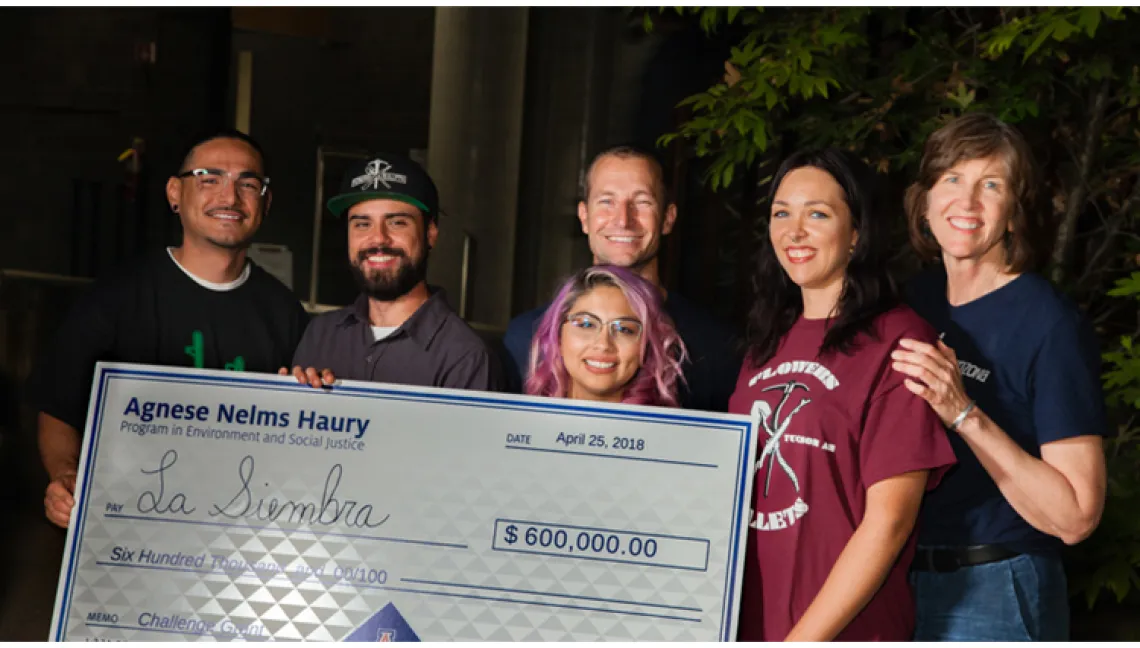New Haury Grant Centers On Habitat Restoration

From left: Tito Romero (of Flowers and Bullets Collective, or FB); Jacob Robles (FB); Moses Thompson (Tucson Unified School District); Silvia Isabel Valdillez (FB), Heather Gray (FB) and Sallie Marston (UA). (Photo: Matt Doolen)
The winning La Siembra project involves the community in the planning, development, implementation and evaluation of an urban farm on the vacant site of the former Julia Keen Elementary School.
A team from the University of Arizona Community and School Garden Program, or CSGP, and the Flowers and Bullets Collective has won a $600,000 challenge grant from the Agnese Nelms Haury Program in Environment and Social Justice to focus on habitat restoration and cultural heritage projects in an underserved Tucson neighborhood.
The project, "La Siembra: Sowing a New Model of Community Engagement Through Urban Agriculture," will help strengthen the capabilities and self-sufficiency of a growing number of young leaders and community members from Barrio Centro.
The three-year project centers community voices in the planning, development, implementation and evaluation of an urban farm on the vacant site of the former Julia Keen Elementary School. Through this project, CSGP extends its long-term efforts in schools to this new neighborhood facility. "La Siembra" proposes a model of community engagement in which all participants bring different abilities to the table to create an authentic and sustained partnership, team members said.
"The urban farm will not only make food affordable, but it can also transform the dynamic of our communities by creating opportunities, jobs and skills not just for those folks who are coming out of prison or dealing with abuse, but for people before they are getting into trouble, and that's community safety and wellness," said Tito Romero, outreach coordinator for the Flowers and Bullets Collective, which creates outlets for underserved youth and communities through arts and sustainability. "This could be an example of what you can do in other communities."
Sallie Marston, a professor in the UA's School of Geography and Development, and Moses Thompson, a coordinator with CSGP, will manage the project. By the conclusion of the three years, members of the Flowers and Bullets Collective will be prepared to take the management of the farm. The YWCA and Tucson Unified School District also are team members.
"We are beyond inspired to work with both Flowers and Bullets and the Haury Program in Environment and Social Justice to help launch the Midtown Farm in Barrio Centro," Thompson said. "This project leverages the resources of the UA to amplify a community-driven solution to disparities in food and greenspace access. We're confident impact will be felt both regionally and beyond as we work to create a more socially just model of university-community partnership."
During the April 25 event, three finalist teams each made a short presentation at the UA's Environment and Natural Resources 2 building before a panel of judges in the Agnese Nelms Haury Lecture Hall.
The other two challenge grant finalists were the Sustainable Off-Grid San Carlos Apache Water Purification Project, led by Vasiliki Karanikola, a research professor in the UA's College of Engineering, partnering with Bryce Barnes, Nalwoodi Denzhone Community board president; and the Low-Income Solar Loan Pilot Program, led by Ann Marie Wolf, president of the Sonora Environmental Research Institute Inc., and Diane Austin, a professor in the UA's School of Anthropology.
"'La Siembra' extends the focus of Haury program challenge grant projects to food security," said Anna Spitz, director of the Haury program. "The project, along with those selected in 2016 and 2017, has strong educational components, which extend knowledge, capacity and leadership of younger generations at the UA and in communities."
The 2016 and 2017 winning projects, respectively, were "K’é bee da'ahiiniita: Strength Through the Navajo Clan System to Respond to the Gold King Mine Spill," led by UA researchers Karletta Chief and Paloma Beamer, and "Preparing the Next Generation of Native American and Hispanic STEM Innovators," led by UA assistant extension specialist Gerardo Lopez.
This year's event also showcased music and literature in a tribute to the interests of the late Agnese Nelms Haury and to honor her legacy of philanthropy. Tiezheng Shen, an award-winning violist from the UA's Fred Fox School of Music, and pianist Chia-Chun Ko, who received her Doctor of Musical Arts in Piano Performance from the UA, performed excerpts from the viola concerto "Do Not Go Gentle…," composed by Richard Wernick. The Agnese N. Lindley Foundation commissioned the concerto in 1985.
Francisco Cantú, writer and coordinator of the UA's Southwest Field Studies in Writing program, funded by the Haury program, read from his book "The Line Becomes a River: Dispatches From the Border."
The evening program also included comments from Tannis Gibson, interim dean of the UA's College of Fine Arts, and Mary Grier, a member of the Haury program donor-advised fund board.
"The wonderful program that preceded the final presentation by the Haury challenge grant finalists showcased the talents of extraordinary musicians and writers. Mrs. Haury would have enjoyed these performances tremendously," Grier said. "The three extraordinary teams who presented their grand ideas during the evening brought the creative talent, energy and skills of university and community partnerships to solve a piece of the wicked problem that faces humanity: how to develop socially just solutions to environmental problems."
Article written by University Communications.

